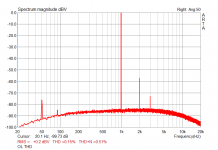Today with availability of semiconductor coolers temperature can be kept below minimal ambient temperature level, but it creates moisture problem.
Wait a minute.
First heating above ambient temperature, now cooling below ambient temperature.
I think I’ll have some pills.
I know about the good name of the Tomsk Polytechnic Institute, but I was not aware of this exciter.
George
Polytechnic institute is an educational one. NIIPP is a scientific one.
Here is their modern online store. Google Translate
Looks like Russian electronic industry went down to China...
Here is their modern online store. Google Translate
Looks like Russian electronic industry went down to China...
I discovered the hard way that aluminum wire to gold plated Kovar has a residual 2-3uV/C thermocouple potential.
Scott, have you looked on such potentials from copper to solder to copper or copper/gold plating to solder to copper ? (moving coil cartridges and microphones circuits)
George
I think I’ll have some pills.
George
The question is....the red one, or the blue one...
jn
Scott, have you looked on such potentials from copper to solder to copper or copper/gold plating to solder to copper ? (moving coil cartridges and microphones circuits)
George
No such research is a lot of work and I asked one of the foremost experts in the field and he told me he knew of very little (none?) literature on thermocouples with thin different metal films.
I actually made little knots of gold and aluminum 1 mil wire by hand.
77 K is far too cold for good performance with silicon JFETs.
May I ask why?
Is this true for bipolars too?
(Lack of basic knowledge. I thought I knew that lowering temperature lowers every kind of semiconductor noise )
George
The question is....the red one, or the blue one...
jn
Ooops !
The only blue pill that comes to my mind is Viagra
What about the red one ?
George
Ooops !
The only blue pill that comes to my mind is Viagra
What about the red one ?
George
Matrix....
jn
Attachments
May I ask why?
Is this true for bipolars too?
(Lack of basic knowledge. I thought I knew that lowering temperature lowers every kind of semiconductor noise )
George
Obscure, here you go germanium JFET's at 4.2K.
http://ntrs.nasa.gov/archive/nasa/casi.ntrs.nasa.gov/20000031730_2000033912.pdf
May I ask why?
Is this true for bipolars too?
(Lack of basic knowledge. I thought I knew that lowering temperature lowers every kind of semiconductor noise )
George
I think it's because the electrons didn't bring any thermal underwear, so when they get to the wall, they are not able to climb over it..but shiver instead..
At really low temps, the pn junctions actually become insulating to the tune of 3 to 30 volts depending on diffusion profile.
jn
Matrix....
jn
I think it's because the electrons didn't bring any thermal underwear,
jn
George,
I think the red pills are the ones you take if you took to many blue ones.......
I’ll have a beer.
I really enjoy your company.
Cheers to all of you

George
(Just before the beer)
I am surprised.
First by the answer from the experts, as I think that this problem had to be addressed in microcircuits and micromachines.
Second by the “research” on copper/solder/copper. What research? This is the most common/dominating case of electrical connection in electronic circuits for how many decades?
How many?
George
No such research is a lot of work and I asked one of the foremost experts in the field and he told me he knew of very little (none?) literature on thermocouples with thin different metal films.
I am surprised.
First by the answer from the experts, as I think that this problem had to be addressed in microcircuits and micromachines.
Second by the “research” on copper/solder/copper. What research? This is the most common/dominating case of electrical connection in electronic circuits for how many decades?
I actually made little knots of gold and aluminum 1 mil wire by hand.
How many?
George
coluke, what kind of distortion figures/spectrum do you get OPEN LOOP?
Did a very quick and dirty test (see attached sample FFT run): open loop THD @ 1kHz, ~0dBV into 30 ohm is about 0.15%, only low order. OLG is about 62 dB, OLBW > 20 kHz. Closing the loop at 10 dB gain leaves you with about 50+ dB of loop gain midband - closed loop THD should be even less than the figure I've got (0.0013%). Actually the baby is quite polite

Ciao,
L.
Attachments
George,
Thanks and raise that glass. No funny faces I can't see where they are coming from.
On the question of copper lead copper or similar metals aren't any of these going to be a basic battery through simple electrolysis of dis-similar metals? One of the metals is going to give up atoms or electrons to the other isn't it?
Thanks and raise that glass. No funny faces I can't see where they are coming from.
On the question of copper lead copper or similar metals aren't any of these going to be a basic battery through simple electrolysis of dis-similar metals? One of the metals is going to give up atoms or electrons to the other isn't it?
jneutron,
Very off topic, but if you take a super-conductor to very low temperatures it will stop the flow of electrons then? Just made me wonder your comment to George.
I am not a Jneutron, but even I know the difference between current flow of blue pills in conductors and jumping of red pills over potential barriers!
Did a very quick and dirty test (see attached sample FFT run): open loop THD @ 1kHz, ~0dBV into 30 ohm is about 0.15%, only low order. OLG is about 62 dB, OLBW > 20 kHz. .....
Thanks, coluke, that's very informative.
Noise floor in the pictue looks strange, though. Are you using weighting filter?
It may lower noise, but lower temperatures definitely lowers conductivity of semiconductors, and at lower temperatures they just won't turn on. The whole physics and chemistry of silicon and germanium, energy levels, conductivity and how it's affected by doping and temperature is explained in just about every textbook on transistors (now, "semiconductors" to include ICs/chips). At the time (when I was in college, late 1970's) I thought it was pretty useless information unless one was going to work in a transistor manufacturing plant, but now my opinion is one can't have too much knowledge.May I ask why?
Is this true for bipolars too?
(Lack of basic knowledge. I thought I knew that lowering temperature lowers every kind of semiconductor noise )
George
- Home
- Source & Line
- Analog Line Level
- Discrete Opamp Open Design

